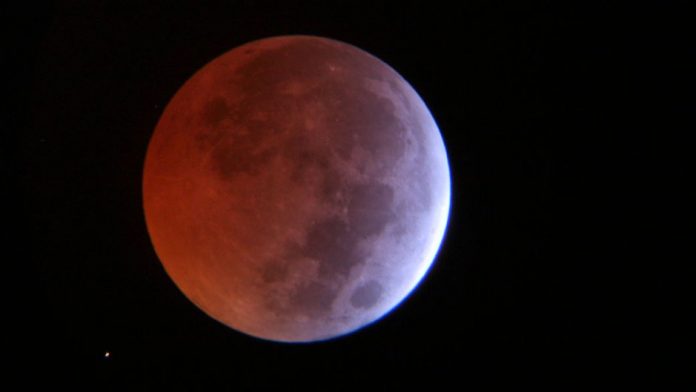Mark your calendars: on the night of September 27, 2015, the full moon will be coloured red as it passes into the Earth’s shadow for 72 minutes in a total lunar eclipse. You can think of it as the light from every sunrise and sunset on Earth being cast onto the moon.
The eclipse will be visible across North America and South America, and in some parts of Europe and Asia.
Read on to find out everything you need to know to make the most of your viewing, the combination of events that make this month’s eclipse extra special, and what scientists have learned from watching lunar eclipses.
Sign up for automatic reminders by joining our Facebook event page.
The 2015 Supermoon lunar eclipse
Animation courtesy of NASA Goddard
Viewing the eclipse
There are several phases to a total lunar eclipse. It begins as the moon enters a part of the Earth’s shadow called the penumbra, and it will appear to dim. Once the moon is inside the Earth’s umbra, the eclipse is said to have entered totality, and the moon will take on a red or orange colour.
The beautiful shades of orange and red in Earth’s shadow come from its atmosphere, which scatters white light from the sun, leaving shades of red that you see during sunrise and sunset.
This will happen at 10:11 pm Eastern Daylight Time, or at 7:11 pm Pacific Daylight Time. Totality will last for 72 minutes, ending at 11:23 pm Eastern, or 8:23 pm Pacific. Check out Wikipedia for a table for the timing of each major event in the eclipse by time zone.
Be especially alert as the moon enters and exits totality, as you may spot a brief flash of blue or turquoise as the moon is illuminated by Earth’s ozone in the upper atmosphere.
Weather permitting, the eclipse will be equally visible from the city as the country, and it is safe to look directly at the moon with no special equipment.
The full moon will be a supermoon
The moon orbits the Earth in an elliptical path that is not perfectly centered – this means that sometimes the moon is further away (the furthest point is called the apogee), and sometimes it is closer (the closest point is called the perigee). On the night of the eclipse, the moon will be near its closest approach to the Earth and will appear about 7% larger than it does on average. The last time a total lunar eclipse coincided with a supermoon was all the way back in 1982.
The full moon will be a harvest moon
This is the full moon closest to the Fall Equinox – so day and night will be of almost equal length. The sun will also rise exactly in the east, and set exactly in the west. And if you head over to Chinatown, there will also be mooncakes!
The eclipse will be the fourth in a tetrad
Not all lunar eclipses are total – some are only partial. There does not seem to be a pattern, so total and partial eclipses can happen in any order. However, every so often there are four total eclipses in a row, and this series is called a tetrad. There will be nine tetrads in the 21st century, but there were no tetrads from 1600-1900.
What is a tetrad, and what would the eclipse look like from the moon?
Video courtesy of ScienceAtNASA
What have scientists learned from observing lunar eclipses?
One of the simplest observations that you can make from watching the eclipse is proof that the Earth is round: no matter how many lunar eclipses you see, the Earth’s shadow always looks circular.
More complex, ancient astronomers used to use the position of the moon to study the relative positions of the stars. Normally the sun is not visible at night, but during a lunar eclipse, the sun, moon, and Earth are all in a straight line, so the position of the sun also be found. By looking at historical records, astronomers found that the positions of the constellations changed over long periods of time, leading to the observation that the Earth wobbles as it spins.
Are you planning to view the supermoon lunar eclipse? Tweet your photos to @r2rnow.








































